Ethical Dilemma in Nursing: Balancing Care and Restraint
VerifiedAdded on 2020/05/04
|7
|2057
|110
Essay
AI Summary
This essay presents an ethical dilemma in nursing, centered on the case of a patient with drug-related psychosis and the use of restraint. It examines the conflict between the nurse's duty of care, patient rights, and the safety of other patients and healthcare professionals. The essay analyzes the situation through the lens of professional codes of ethics, conduct, ethical theories (utilitarianism and deontology), and human rights. It highlights the importance of balancing patient autonomy, liberty, and the prevention of harm. The discussion includes the impact of restraint on the patient's dignity and mental health, as well as the ethical implications of the nurse's actions. The author recommends developing safe alternatives to restraints and personalized, trauma-informed interventions. The essay concludes with a critical reflection on the ethical considerations and provides recommendations for improved nursing practice.
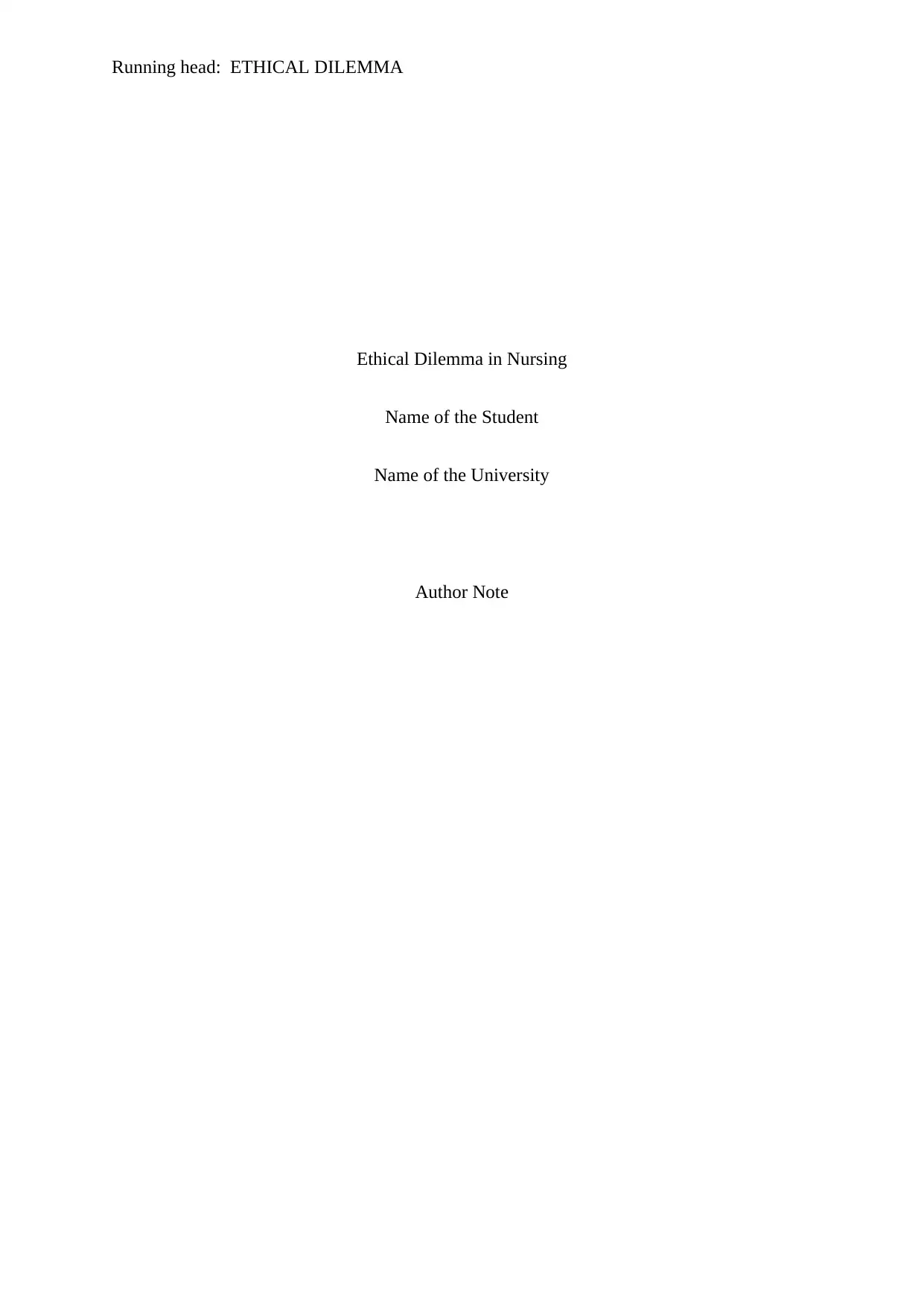
Running head: ETHICAL DILEMMA
Ethical Dilemma in Nursing
Name of the Student
Name of the University
Author Note
Ethical Dilemma in Nursing
Name of the Student
Name of the University
Author Note
Paraphrase This Document
Need a fresh take? Get an instant paraphrase of this document with our AI Paraphraser
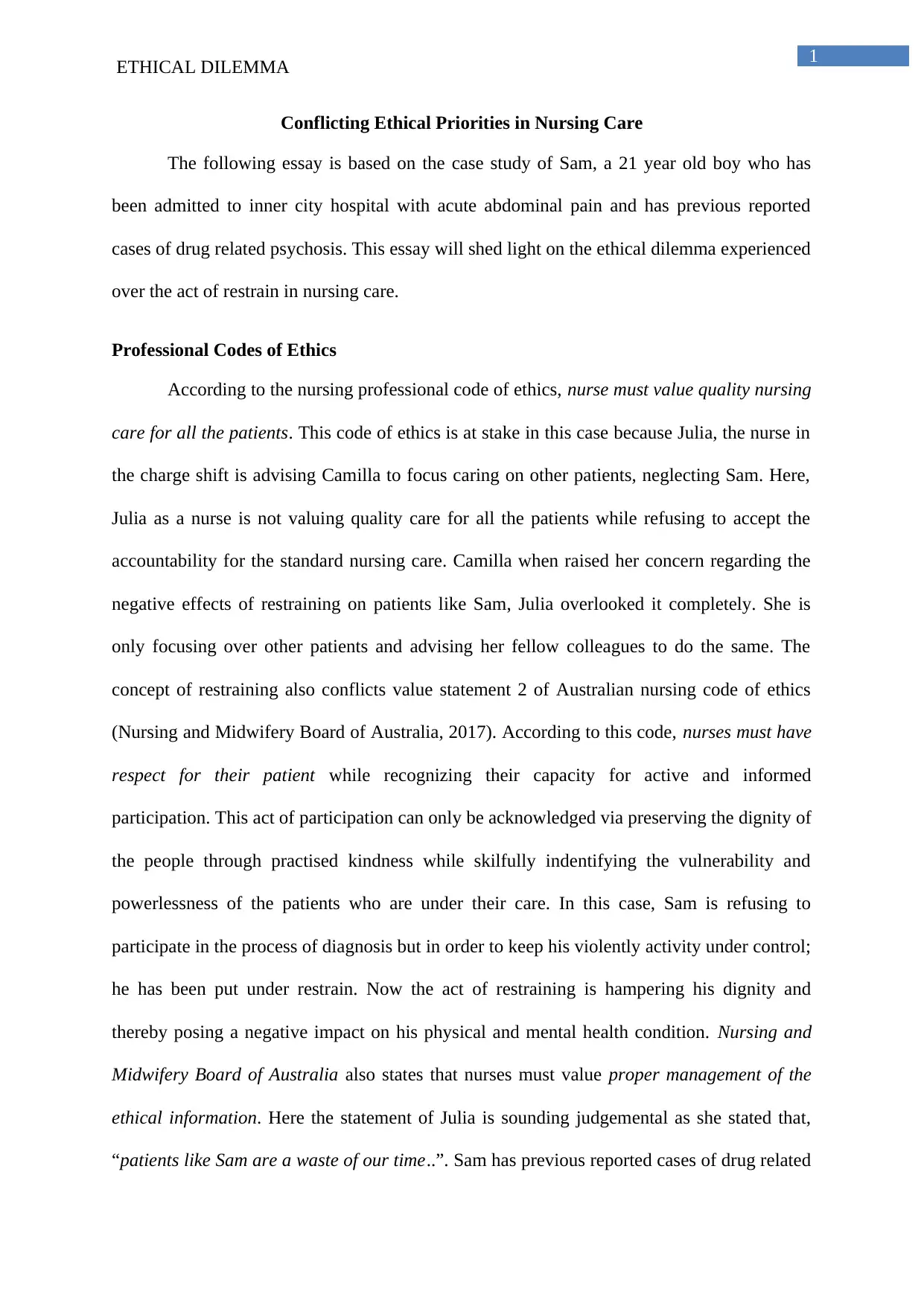
1
ETHICAL DILEMMA
Conflicting Ethical Priorities in Nursing Care
The following essay is based on the case study of Sam, a 21 year old boy who has
been admitted to inner city hospital with acute abdominal pain and has previous reported
cases of drug related psychosis. This essay will shed light on the ethical dilemma experienced
over the act of restrain in nursing care.
Professional Codes of Ethics
According to the nursing professional code of ethics, nurse must value quality nursing
care for all the patients. This code of ethics is at stake in this case because Julia, the nurse in
the charge shift is advising Camilla to focus caring on other patients, neglecting Sam. Here,
Julia as a nurse is not valuing quality care for all the patients while refusing to accept the
accountability for the standard nursing care. Camilla when raised her concern regarding the
negative effects of restraining on patients like Sam, Julia overlooked it completely. She is
only focusing over other patients and advising her fellow colleagues to do the same. The
concept of restraining also conflicts value statement 2 of Australian nursing code of ethics
(Nursing and Midwifery Board of Australia, 2017). According to this code, nurses must have
respect for their patient while recognizing their capacity for active and informed
participation. This act of participation can only be acknowledged via preserving the dignity of
the people through practised kindness while skilfully indentifying the vulnerability and
powerlessness of the patients who are under their care. In this case, Sam is refusing to
participate in the process of diagnosis but in order to keep his violently activity under control;
he has been put under restrain. Now the act of restraining is hampering his dignity and
thereby posing a negative impact on his physical and mental health condition. Nursing and
Midwifery Board of Australia also states that nurses must value proper management of the
ethical information. Here the statement of Julia is sounding judgemental as she stated that,
“patients like Sam are a waste of our time..”. Sam has previous reported cases of drug related
ETHICAL DILEMMA
Conflicting Ethical Priorities in Nursing Care
The following essay is based on the case study of Sam, a 21 year old boy who has
been admitted to inner city hospital with acute abdominal pain and has previous reported
cases of drug related psychosis. This essay will shed light on the ethical dilemma experienced
over the act of restrain in nursing care.
Professional Codes of Ethics
According to the nursing professional code of ethics, nurse must value quality nursing
care for all the patients. This code of ethics is at stake in this case because Julia, the nurse in
the charge shift is advising Camilla to focus caring on other patients, neglecting Sam. Here,
Julia as a nurse is not valuing quality care for all the patients while refusing to accept the
accountability for the standard nursing care. Camilla when raised her concern regarding the
negative effects of restraining on patients like Sam, Julia overlooked it completely. She is
only focusing over other patients and advising her fellow colleagues to do the same. The
concept of restraining also conflicts value statement 2 of Australian nursing code of ethics
(Nursing and Midwifery Board of Australia, 2017). According to this code, nurses must have
respect for their patient while recognizing their capacity for active and informed
participation. This act of participation can only be acknowledged via preserving the dignity of
the people through practised kindness while skilfully indentifying the vulnerability and
powerlessness of the patients who are under their care. In this case, Sam is refusing to
participate in the process of diagnosis but in order to keep his violently activity under control;
he has been put under restrain. Now the act of restraining is hampering his dignity and
thereby posing a negative impact on his physical and mental health condition. Nursing and
Midwifery Board of Australia also states that nurses must value proper management of the
ethical information. Here the statement of Julia is sounding judgemental as she stated that,
“patients like Sam are a waste of our time..”. Sam has previous reported cases of drug related
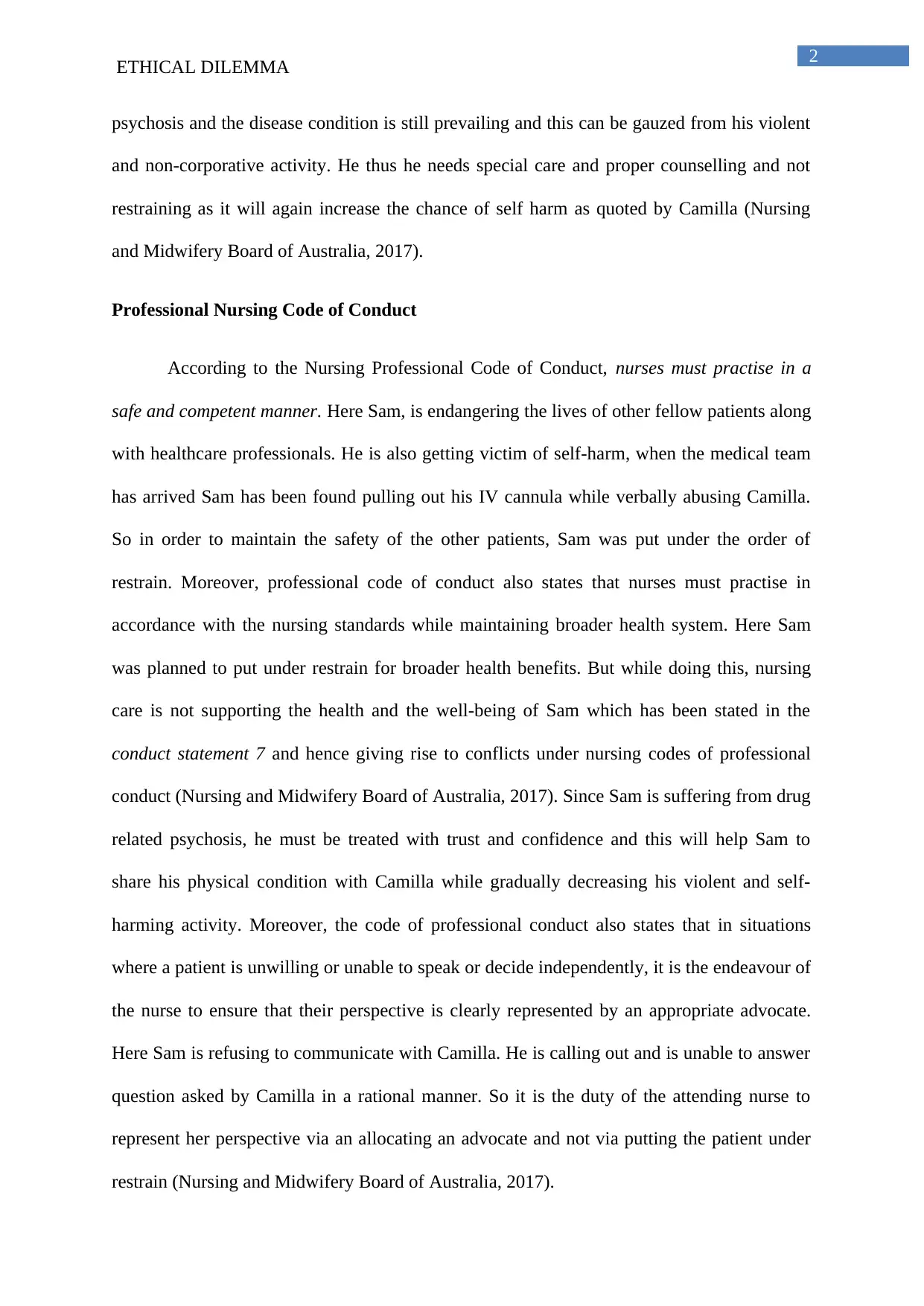
2
ETHICAL DILEMMA
psychosis and the disease condition is still prevailing and this can be gauzed from his violent
and non-corporative activity. He thus he needs special care and proper counselling and not
restraining as it will again increase the chance of self harm as quoted by Camilla (Nursing
and Midwifery Board of Australia, 2017).
Professional Nursing Code of Conduct
According to the Nursing Professional Code of Conduct, nurses must practise in a
safe and competent manner. Here Sam, is endangering the lives of other fellow patients along
with healthcare professionals. He is also getting victim of self-harm, when the medical team
has arrived Sam has been found pulling out his IV cannula while verbally abusing Camilla.
So in order to maintain the safety of the other patients, Sam was put under the order of
restrain. Moreover, professional code of conduct also states that nurses must practise in
accordance with the nursing standards while maintaining broader health system. Here Sam
was planned to put under restrain for broader health benefits. But while doing this, nursing
care is not supporting the health and the well-being of Sam which has been stated in the
conduct statement 7 and hence giving rise to conflicts under nursing codes of professional
conduct (Nursing and Midwifery Board of Australia, 2017). Since Sam is suffering from drug
related psychosis, he must be treated with trust and confidence and this will help Sam to
share his physical condition with Camilla while gradually decreasing his violent and self-
harming activity. Moreover, the code of professional conduct also states that in situations
where a patient is unwilling or unable to speak or decide independently, it is the endeavour of
the nurse to ensure that their perspective is clearly represented by an appropriate advocate.
Here Sam is refusing to communicate with Camilla. He is calling out and is unable to answer
question asked by Camilla in a rational manner. So it is the duty of the attending nurse to
represent her perspective via an allocating an advocate and not via putting the patient under
restrain (Nursing and Midwifery Board of Australia, 2017).
ETHICAL DILEMMA
psychosis and the disease condition is still prevailing and this can be gauzed from his violent
and non-corporative activity. He thus he needs special care and proper counselling and not
restraining as it will again increase the chance of self harm as quoted by Camilla (Nursing
and Midwifery Board of Australia, 2017).
Professional Nursing Code of Conduct
According to the Nursing Professional Code of Conduct, nurses must practise in a
safe and competent manner. Here Sam, is endangering the lives of other fellow patients along
with healthcare professionals. He is also getting victim of self-harm, when the medical team
has arrived Sam has been found pulling out his IV cannula while verbally abusing Camilla.
So in order to maintain the safety of the other patients, Sam was put under the order of
restrain. Moreover, professional code of conduct also states that nurses must practise in
accordance with the nursing standards while maintaining broader health system. Here Sam
was planned to put under restrain for broader health benefits. But while doing this, nursing
care is not supporting the health and the well-being of Sam which has been stated in the
conduct statement 7 and hence giving rise to conflicts under nursing codes of professional
conduct (Nursing and Midwifery Board of Australia, 2017). Since Sam is suffering from drug
related psychosis, he must be treated with trust and confidence and this will help Sam to
share his physical condition with Camilla while gradually decreasing his violent and self-
harming activity. Moreover, the code of professional conduct also states that in situations
where a patient is unwilling or unable to speak or decide independently, it is the endeavour of
the nurse to ensure that their perspective is clearly represented by an appropriate advocate.
Here Sam is refusing to communicate with Camilla. He is calling out and is unable to answer
question asked by Camilla in a rational manner. So it is the duty of the attending nurse to
represent her perspective via an allocating an advocate and not via putting the patient under
restrain (Nursing and Midwifery Board of Australia, 2017).
⊘ This is a preview!⊘
Do you want full access?
Subscribe today to unlock all pages.

Trusted by 1+ million students worldwide
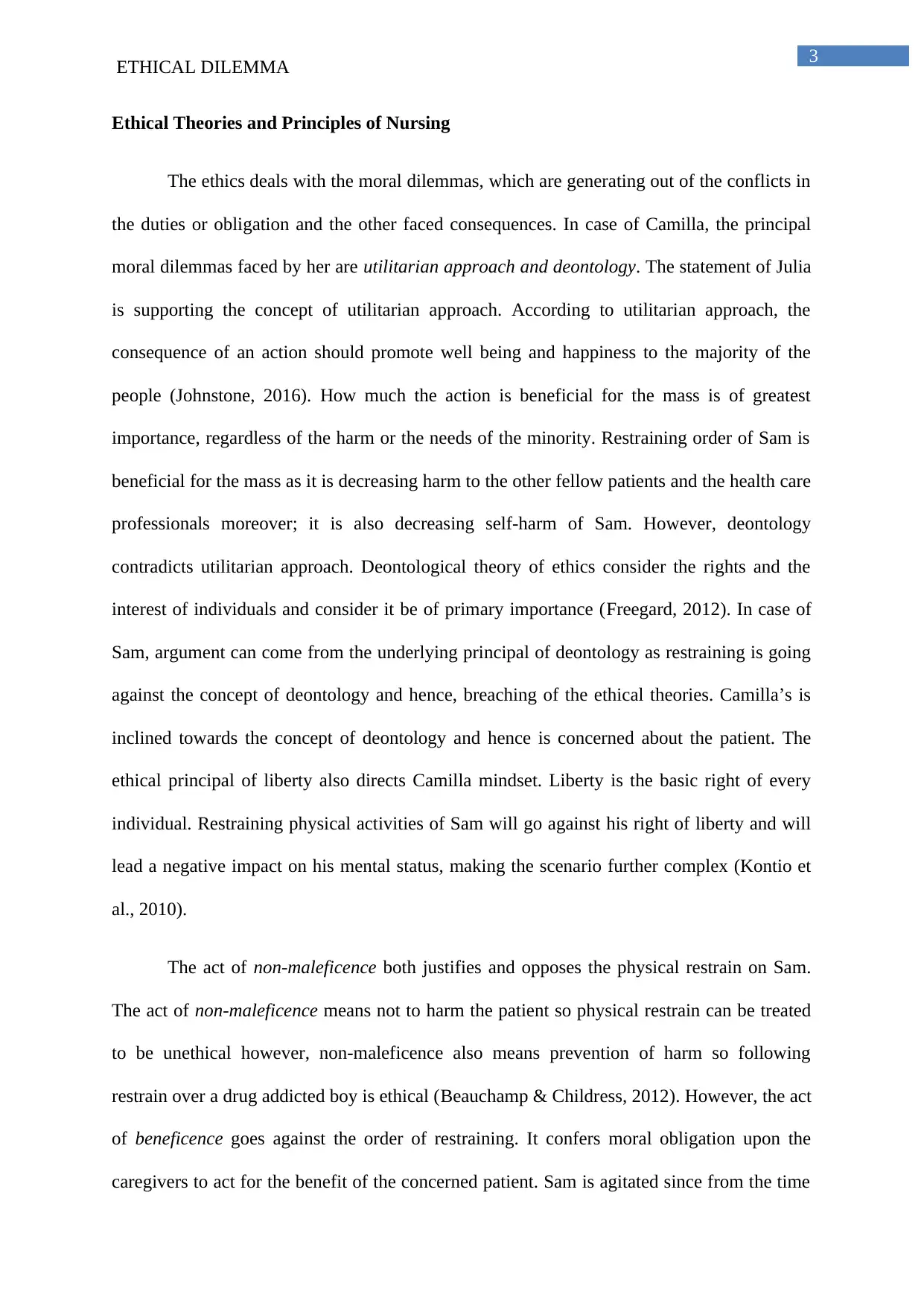
3
ETHICAL DILEMMA
Ethical Theories and Principles of Nursing
The ethics deals with the moral dilemmas, which are generating out of the conflicts in
the duties or obligation and the other faced consequences. In case of Camilla, the principal
moral dilemmas faced by her are utilitarian approach and deontology. The statement of Julia
is supporting the concept of utilitarian approach. According to utilitarian approach, the
consequence of an action should promote well being and happiness to the majority of the
people (Johnstone, 2016). How much the action is beneficial for the mass is of greatest
importance, regardless of the harm or the needs of the minority. Restraining order of Sam is
beneficial for the mass as it is decreasing harm to the other fellow patients and the health care
professionals moreover; it is also decreasing self-harm of Sam. However, deontology
contradicts utilitarian approach. Deontological theory of ethics consider the rights and the
interest of individuals and consider it be of primary importance (Freegard, 2012). In case of
Sam, argument can come from the underlying principal of deontology as restraining is going
against the concept of deontology and hence, breaching of the ethical theories. Camilla’s is
inclined towards the concept of deontology and hence is concerned about the patient. The
ethical principal of liberty also directs Camilla mindset. Liberty is the basic right of every
individual. Restraining physical activities of Sam will go against his right of liberty and will
lead a negative impact on his mental status, making the scenario further complex (Kontio et
al., 2010).
The act of non-maleficence both justifies and opposes the physical restrain on Sam.
The act of non-maleficence means not to harm the patient so physical restrain can be treated
to be unethical however, non-maleficence also means prevention of harm so following
restrain over a drug addicted boy is ethical (Beauchamp & Childress, 2012). However, the act
of beneficence goes against the order of restraining. It confers moral obligation upon the
caregivers to act for the benefit of the concerned patient. Sam is agitated since from the time
ETHICAL DILEMMA
Ethical Theories and Principles of Nursing
The ethics deals with the moral dilemmas, which are generating out of the conflicts in
the duties or obligation and the other faced consequences. In case of Camilla, the principal
moral dilemmas faced by her are utilitarian approach and deontology. The statement of Julia
is supporting the concept of utilitarian approach. According to utilitarian approach, the
consequence of an action should promote well being and happiness to the majority of the
people (Johnstone, 2016). How much the action is beneficial for the mass is of greatest
importance, regardless of the harm or the needs of the minority. Restraining order of Sam is
beneficial for the mass as it is decreasing harm to the other fellow patients and the health care
professionals moreover; it is also decreasing self-harm of Sam. However, deontology
contradicts utilitarian approach. Deontological theory of ethics consider the rights and the
interest of individuals and consider it be of primary importance (Freegard, 2012). In case of
Sam, argument can come from the underlying principal of deontology as restraining is going
against the concept of deontology and hence, breaching of the ethical theories. Camilla’s is
inclined towards the concept of deontology and hence is concerned about the patient. The
ethical principal of liberty also directs Camilla mindset. Liberty is the basic right of every
individual. Restraining physical activities of Sam will go against his right of liberty and will
lead a negative impact on his mental status, making the scenario further complex (Kontio et
al., 2010).
The act of non-maleficence both justifies and opposes the physical restrain on Sam.
The act of non-maleficence means not to harm the patient so physical restrain can be treated
to be unethical however, non-maleficence also means prevention of harm so following
restrain over a drug addicted boy is ethical (Beauchamp & Childress, 2012). However, the act
of beneficence goes against the order of restraining. It confers moral obligation upon the
caregivers to act for the benefit of the concerned patient. Sam is agitated since from the time
Paraphrase This Document
Need a fresh take? Get an instant paraphrase of this document with our AI Paraphraser

4
ETHICAL DILEMMA
of admission in the hospital and was refusing to cooperate with the Camilla. He was again
found pushing and verbally abusing Camilla, hampering her human dignity. Her principle of
beneficence promise maximum benefits to Sam in regards physical injury or self-harm
(Kerridge, Lowe & Stewart, 2013).
Human Rights and Human Dignity
According to the nursing professional code of conduct, nurses must not contravene
the law or breach the human rights of any patients assigned under their care. It is the moral
duty of the nursing professionals to skillfully recognize the universal human rights of their
patients in order to safeguard their inherent dignity. This is due to the fact that there lies a
critical relationship between the health and human rights. Lack of attention in the domain of
human rights and impose serious health threats. This existence of inherent relationship is
reflected under the concerns of Camilla who is of the opinion that the act of restrain as
imposed on Sam will increase the chance of self-harm. It is the duty of the nurse to safeguard
the rights of all the patients at highest achievable standards of health. However, the act of
restraining is going against the human rights (Lin, Watson & Tsai, 2013). Though restrain
was done to prevent him from self-harming but it is going against his human rights. But on
the other hand, if Sam is set free, then his agitated activity will not only cause self-harm but
also will harm other fellow patients who also have equal share of staying fit and well
(Nursing and Midwifery Board of Australia, 2017).
Position Statement: Recommendation via Reflection
The first recommendation, which I would like to suggest in this case, is through
research to develop safe alternatives to restraints so that it does not harm patient’s dignity and
act of libertarianism and autonomy. Moreover, I strongly feel that there is an immediate
requirement for proper development of personalized, trauma-informed interventions. Such
ETHICAL DILEMMA
of admission in the hospital and was refusing to cooperate with the Camilla. He was again
found pushing and verbally abusing Camilla, hampering her human dignity. Her principle of
beneficence promise maximum benefits to Sam in regards physical injury or self-harm
(Kerridge, Lowe & Stewart, 2013).
Human Rights and Human Dignity
According to the nursing professional code of conduct, nurses must not contravene
the law or breach the human rights of any patients assigned under their care. It is the moral
duty of the nursing professionals to skillfully recognize the universal human rights of their
patients in order to safeguard their inherent dignity. This is due to the fact that there lies a
critical relationship between the health and human rights. Lack of attention in the domain of
human rights and impose serious health threats. This existence of inherent relationship is
reflected under the concerns of Camilla who is of the opinion that the act of restrain as
imposed on Sam will increase the chance of self-harm. It is the duty of the nurse to safeguard
the rights of all the patients at highest achievable standards of health. However, the act of
restraining is going against the human rights (Lin, Watson & Tsai, 2013). Though restrain
was done to prevent him from self-harming but it is going against his human rights. But on
the other hand, if Sam is set free, then his agitated activity will not only cause self-harm but
also will harm other fellow patients who also have equal share of staying fit and well
(Nursing and Midwifery Board of Australia, 2017).
Position Statement: Recommendation via Reflection
The first recommendation, which I would like to suggest in this case, is through
research to develop safe alternatives to restraints so that it does not harm patient’s dignity and
act of libertarianism and autonomy. Moreover, I strongly feel that there is an immediate
requirement for proper development of personalized, trauma-informed interventions. Such
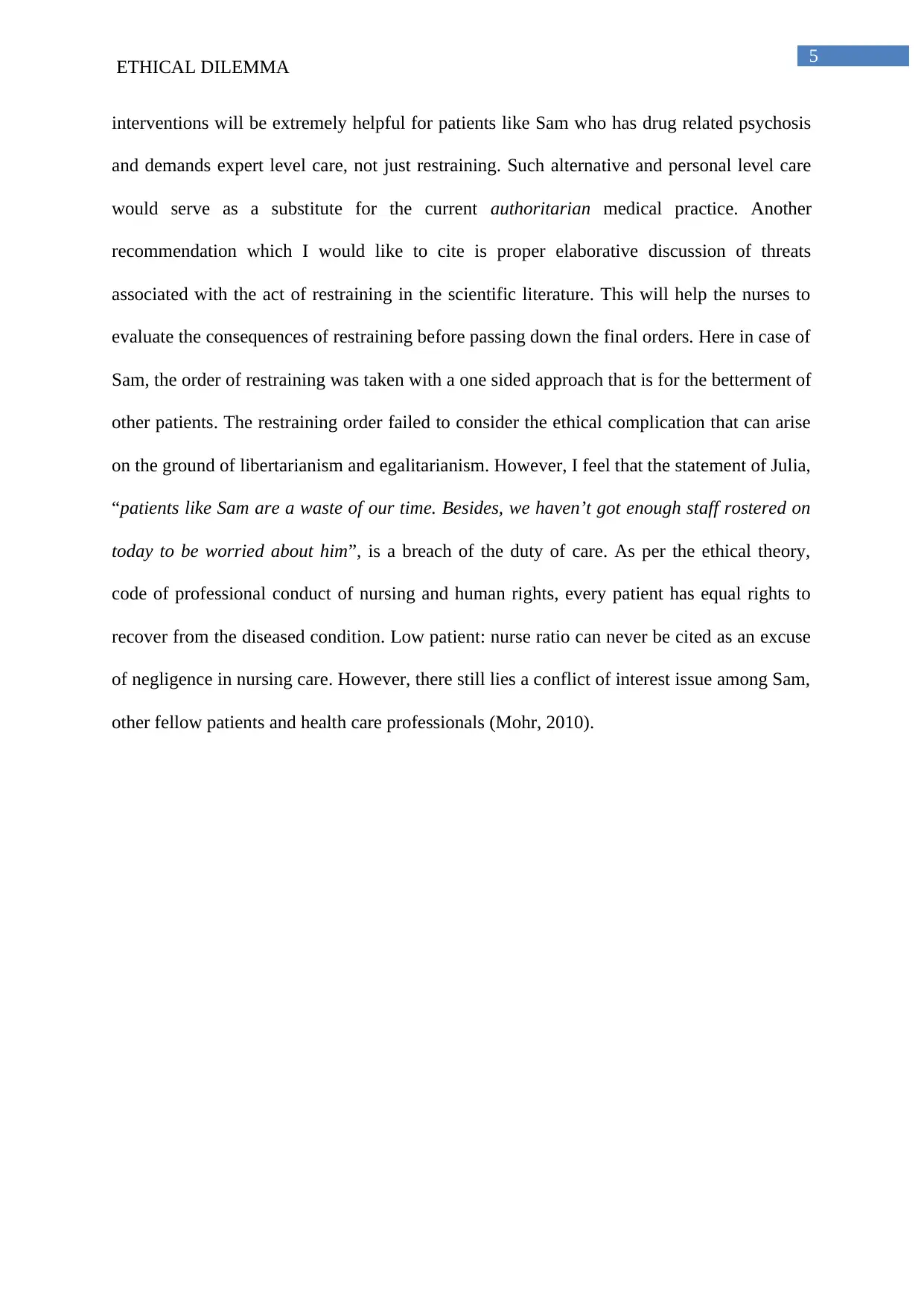
5
ETHICAL DILEMMA
interventions will be extremely helpful for patients like Sam who has drug related psychosis
and demands expert level care, not just restraining. Such alternative and personal level care
would serve as a substitute for the current authoritarian medical practice. Another
recommendation which I would like to cite is proper elaborative discussion of threats
associated with the act of restraining in the scientific literature. This will help the nurses to
evaluate the consequences of restraining before passing down the final orders. Here in case of
Sam, the order of restraining was taken with a one sided approach that is for the betterment of
other patients. The restraining order failed to consider the ethical complication that can arise
on the ground of libertarianism and egalitarianism. However, I feel that the statement of Julia,
“patients like Sam are a waste of our time. Besides, we haven’t got enough staff rostered on
today to be worried about him”, is a breach of the duty of care. As per the ethical theory,
code of professional conduct of nursing and human rights, every patient has equal rights to
recover from the diseased condition. Low patient: nurse ratio can never be cited as an excuse
of negligence in nursing care. However, there still lies a conflict of interest issue among Sam,
other fellow patients and health care professionals (Mohr, 2010).
ETHICAL DILEMMA
interventions will be extremely helpful for patients like Sam who has drug related psychosis
and demands expert level care, not just restraining. Such alternative and personal level care
would serve as a substitute for the current authoritarian medical practice. Another
recommendation which I would like to cite is proper elaborative discussion of threats
associated with the act of restraining in the scientific literature. This will help the nurses to
evaluate the consequences of restraining before passing down the final orders. Here in case of
Sam, the order of restraining was taken with a one sided approach that is for the betterment of
other patients. The restraining order failed to consider the ethical complication that can arise
on the ground of libertarianism and egalitarianism. However, I feel that the statement of Julia,
“patients like Sam are a waste of our time. Besides, we haven’t got enough staff rostered on
today to be worried about him”, is a breach of the duty of care. As per the ethical theory,
code of professional conduct of nursing and human rights, every patient has equal rights to
recover from the diseased condition. Low patient: nurse ratio can never be cited as an excuse
of negligence in nursing care. However, there still lies a conflict of interest issue among Sam,
other fellow patients and health care professionals (Mohr, 2010).
⊘ This is a preview!⊘
Do you want full access?
Subscribe today to unlock all pages.

Trusted by 1+ million students worldwide

6
ETHICAL DILEMMA
References
Beauchamp, T. L., & Childress, J. F. (2012). Principles of Biomedical Ethics (7th ed.). New
York: Oxford University Press
Code of Ethics for Nurses in Australia. (2005) (2nd ed., pp. 1-6). Melbourne. Retrieved from
http://www.nursingmidwiferyboard.gov.au
Code of Professional Conduct for Nurses in Australia (2017). Melbourne. Retrieved from
http://www.nursingmidwiferyboard.gov.au
Freegard, H. (2012). Ethical practice for health professionals. (2nd ed.). Melbourne:
Cengage. Available at: https://ebookcentral.proquest.com/lib/acu/detail.action?
docID=4814208
Johnstone, M. (2016). Bioethics : A Nursing Perspective. (6th Ed.). Chatswood, NSW:
Elsevier.
Kerridge, I., Lowe, M., & Stewart, C. (2013). Ethics and Law for the Health Professions (4th
ed.). Sydney: The Federation Press.
Kontio, R., Välimäki, M., Putkonen, H., Kuosmanen, L., Scott, A., &Joffe, G. (2010). Patient
restrictions: are there ethical alternatives to seclusion and restraint?. Nursing
ethics, 17(1), 65-76.
Lin, Y. P., Watson, R., & Tsai, Y. F. (2013). Dignity in care in the clinical setting: A
narrative review. Nursing Ethics, 20(2), 168-177.retrieved from
http://journals.sagepub.com/doi/abs/10.1177/0969733012458609
Mohr, W. K. (2010). Restraints and the code of ethics: An uneasy fit. Archives of psychiatric
nursing, 24(1), 3-14.
ETHICAL DILEMMA
References
Beauchamp, T. L., & Childress, J. F. (2012). Principles of Biomedical Ethics (7th ed.). New
York: Oxford University Press
Code of Ethics for Nurses in Australia. (2005) (2nd ed., pp. 1-6). Melbourne. Retrieved from
http://www.nursingmidwiferyboard.gov.au
Code of Professional Conduct for Nurses in Australia (2017). Melbourne. Retrieved from
http://www.nursingmidwiferyboard.gov.au
Freegard, H. (2012). Ethical practice for health professionals. (2nd ed.). Melbourne:
Cengage. Available at: https://ebookcentral.proquest.com/lib/acu/detail.action?
docID=4814208
Johnstone, M. (2016). Bioethics : A Nursing Perspective. (6th Ed.). Chatswood, NSW:
Elsevier.
Kerridge, I., Lowe, M., & Stewart, C. (2013). Ethics and Law for the Health Professions (4th
ed.). Sydney: The Federation Press.
Kontio, R., Välimäki, M., Putkonen, H., Kuosmanen, L., Scott, A., &Joffe, G. (2010). Patient
restrictions: are there ethical alternatives to seclusion and restraint?. Nursing
ethics, 17(1), 65-76.
Lin, Y. P., Watson, R., & Tsai, Y. F. (2013). Dignity in care in the clinical setting: A
narrative review. Nursing Ethics, 20(2), 168-177.retrieved from
http://journals.sagepub.com/doi/abs/10.1177/0969733012458609
Mohr, W. K. (2010). Restraints and the code of ethics: An uneasy fit. Archives of psychiatric
nursing, 24(1), 3-14.
1 out of 7
Related Documents
Your All-in-One AI-Powered Toolkit for Academic Success.
+13062052269
info@desklib.com
Available 24*7 on WhatsApp / Email
![[object Object]](/_next/static/media/star-bottom.7253800d.svg)
Unlock your academic potential
Copyright © 2020–2025 A2Z Services. All Rights Reserved. Developed and managed by ZUCOL.





